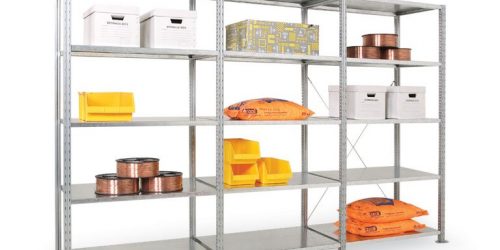The transformation of the warehouse and its businesses
From the poorly lit sheds that first appeared in the 1950s to the connected, e-commerce-friendly complexes that they are fast becoming, warehouses are constantly evolving. While this transformation entails organisational changes for companies, warehouse logistics innovation is also a great opportunity for growth. It improves productivity, storage operations, customer satisfaction, and the well-being of the employees who work there. Automation technology and solutions for the flow of goods are giving a welcome boost to the supply chain sector.
Warehouse automation
The warehouse transformation and its associated business activities are being driven by the automation of tools and processes.
Already well-established digital solutions
Logistics, the supply chain, and product storage began to undergo modernisation in the 1980s, notably with the adoption of barcodes. Nowadays, numerous IT tools are already well established, ensuring improved goods storage management.
Enterprise Resource Planning (ERP)
ERP makes it possible to track orders online, organise the operational departments of warehouses and coordinate all the players involved in the supply chain sector (procurement, human resources, finance, sales, etc.).
WMS (Warehouse Management System)
WMS controls everything that happens in the warehouse: inventory management, goods receipt, and dispatch, and product replenishment. Analysing the information provided by a WMS is therefore a valuable tool for:
- Proposing ways to optimise freight flows and transport;
- Improving task management;
- Adopting the lean methodology in the company’s logistics sector.
Towards increasing automation and robotisation
Automation and robotisation in warehouses might, on the face of it, seem like a cause for concern. What will happen to the jobs of operators working in this sector when technology replaces them? How can we continue to thrive in a work environment that is essentially made up of machines? Yet adopting innovative solutions to modernise the supply chain has many benefits, not only in terms of improved productivity and customer satisfaction.
A more pleasant place to work
With the advent of cobotics (collaborative robotics), technology can now help with tedious operations. By carrying heavy loads or performing strenuous repetitive movements, robots reduce the risk of MSDs (musculoskeletal disorders). Innovations are being developed to offer operators exoskeletons to perform risky operations almost effortlessly.
Improved mobility
Smartphones, tablets, and other mobile devices are valuable innovations for the logistics industry. They offer solutions for working on IT tasks directly in the warehouse, close to the products. As a result, supply chain workers enjoy greater fulfillment and productivity in their company.
Other innovative solutions such as smart glasses, smartphone applications, or voice interfaces can facilitate the work of operators. They allow them to focus solely on their current tasks and thus reduce the risk of errors. In the long run, these small changes will have a highly positive impact on the company’s image in the eyes of its customers.
To find out more, read our article Warehouse 4.0, a sine qua non of the digital warehouse of the future.
Logistics innovations for the warehouse
Beyond workflow automation and robotisation, technology is also being used in warehouses to increase productivity and thereby improve customer satisfaction in the long term.
IoT: the Internet of Things
IoT (the Internet of Things) is about connecting objects to the internet. Not only the goods but also the shelves can be linked to WMS solutions, for example. This enables each product to be tracked individually throughout the supply chain, from procurement to customer delivery.
Knowing how well stocked the various types of products are on the shelves makes it possible to automate replenishment and drastically reduce inventory management costs. Thanks to the IoT, it is easy to access the status of logistics flows in real-time.
Furthermore, by connecting objects in storage, companies can eliminate physical inventories, which are a source of errors and therefore have a negative impact on productivity. In the food industry, the IoT is used to detect products that are close to their expiry date and to reduce food waste.
Having a connected and intelligent supply chain is therefore part of a company’s sustainable CSR process.
Big Data
Having connected goods allows you to collect a certain amount of data on your supply chain:
- When are the peaks and troughs of customer demand?
- Are there more physical or e-commerce sales?
- What leeway is there to optimise inventory management and transport flows?
Thanks to Big Data algorithms, these data can be used to establish predictive models to better manage product flow. Storage and management costs are thus reduced, and resources are mobilised for higher value-added supply chain tasks.
Find out more in our article on smart warehouses.
Towards a different approach to management with Lean Logistics
First developed by the Japanese car manufacturer Toyota, the Lean methodology is based on the elimination of three key constraints:
- Waste;
- Variability;
- Inflexibility.
These 3 themes are well-known issues for warehouses. The Lean methodology has therefore gradually been adapted to the logistics sector with Lean Warehousing or Lean Logistics. This method involves changes in management based on continuous improvement solutions. With the help of technology, valuable information is gathered on flows and companies can therefore implement a progressive strategy of innovation and productivity improvement in several key areas.
Cost reduction
Automation and Big Data make it possible to optimise storage management, particularly by anticipating the right quantity of products. This reduces waste and avoids oversupply, which generates high logistical costs.
By analysing the flow of goods, it is also possible to rethink management with a view to optimising transport, a significant financial element in the supply chain.
Customer service quality
Order errors are dramatically reduced with supply chain automation. As with overstocking, predictive data analysis makes it possible to assess more accurately the quantities that need to be ordered from the supplier and to anticipate demand. This anticipation reduces the risk of stockouts in the supply chain. These can have a negative and lasting impact on the company’s image in the eyes of customers.
Finally, by optimising flows, order processing and delivery times are significantly reduced.
While waiting for connected technology, discover 8 ways to increase productivity in your warehouses.





